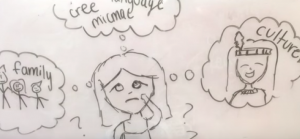For this module’s Weblog, I focus on teachers and educators as I explore the following questions: How can we prepare ourselves to teach from a land-based approach? Where does land-based education fit with place-based learning? What examples are there of students using land-based education to walk in both worlds? I also continue my journey exploring two-eyed seeing and how it helps us understand integrative education.
CBC UnReserved interview with Tasha Spillet: Indigenous Learning on the Land instead of a classroom
In this interview, Tasha Spillet a Cree and Trinidadian Winnepeg educator describes the importance of land-based education for students but also for educators. Ms. Spillet is one of the instructors in the University of Saskatchewan’s land-based education cohort masters degree. She describes how land-based education shifted the way she views herself and the world and she speaks to the importance for educators of engaging in their own land-based education (instead of just reading articles about it). Another interesting feature of this interview was that Ms. Spillet spoke to land-based education in urban settings as benefiting indigenous youth, many of whom are disconnected from their cultural identity and need to be encouraged to also see their urban landscape as their land: “Underneath the concrete is still our land” (Spillet, 2017).
For more about this program, see this article: Land-Based Education: Taking Knowledge back to its roots
Land-based learning brings native and non-native cultures together
“The First” Land-based learning camp (video)
This camp is hosted by the Living Sky School Division. It is purposefully intended to serve Indigenous and non-Indigenous students and restore or rebuild their connection to the land and to each other. Discussion about the initiative emphasizes teaching students to walk in both worlds. “In these classes we have kids that come from both cultures . . . It is important for kids of native culture to realize the importance of keeping their own culture, but it’s just as important for western people to understand that it is a blessing to have First Nation culture alive”. The speaker is Kim Pasche, a Swiss-born experiential archeologist and one of the instructors at the camp. He emphasizes to students that all of them (Indigenous and non-Indigenous came from hunter-gatherer society, but for some of them that society has been lost. Indigenous Elders and educators join non-Indigenous educators to explore the land from both perspectives simultaneously.
Indigenous Land-based Learning Programs
This site, created by a fellow UBC student for ETEC 521, highlights several different land-based learning initiatives offered in Canada (and one in the United States). While discussion of the programs on the site is limited, it does offer a brief analysis of the focus and approach of each camp and serves as a useful portal to investigate different land-based learning initiatives. It includes reference to Integrative Science camps in Nunavut that use Two-Eyed Seeing as their guiding philosophy.
Green Teacher: Education for Planet Earth (Fall 2009 issue)
This issue is dedicated to exploring Two-Eyed Seeing: Integrative Science. It is a treasure trove of work on two-eyed seeing and offers many concrete examples of two-eyed seeing in the context of education. It also links to work on walking in both worlds.
From the editorial: “In this issue we present some of the learning activities that they and others have designed for teaching science in this way, thus enabling students to take the best from both world views, Indigenous and Western” (p. 2). The issue starts with an excellent article by Hatcher, Bartlett, Marshall and Marshall “Two-Eyed Seeing: A cross-cultural science journey” and also includes trans-disciplinary, cross-cultural science units on: birds; traditional medicines; Traditional legends and astronomy; and Solstices and Equinoxes. This issue is highly recommended to anyone looking for a deeper understanding of Two-Eyed Seeing and concrete examples of what it looks like in the classroom.
Decolonization: Indigeneity, Education & Society (December 2014 edition)
I came across this fantastic Special Issue on Indigenous Land-Based Education in my research. It has a number of great articles and in particular a valuable editorial essay entitled “Learning from the land: Indigenous land based pedagogy and decolonization” by Matthew Wildcat, Mandee McDonald, Stephanie Irlbacher-Fox and Glen Coulthard. I appreciated the connection drawn in this article and in the entire issue between land based education and decolonization. I also appreciated the ability to learn about the related experiences of several different Indigenous groups within that context.









